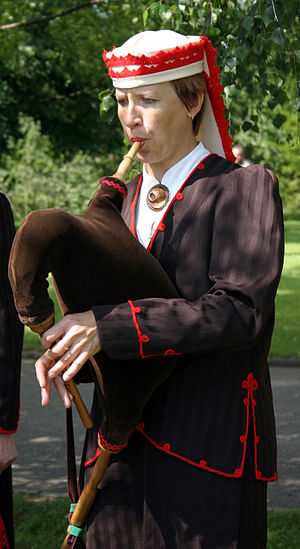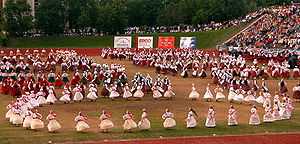Music of Estonia
| Part of a series on the |
| Culture of Estonia |
|---|
 |
| History |
| Languages |
|
Mythology and folklore
|
| Cuisine |
| Religion |
|
Art |
|
Literature
|
|
Music and performing arts |
|
Media
|
| Sport |
|
Monuments
|
|
The earliest mentioning of Estonian singing and dancing dates back to Saxo Grammaticus' Gesta Danorum (c. 1179).[1] Saxo speaks of Estonian warriors who sang at night while waiting for an epic battle. The Estonian folk music tradition is broadly divided into 2 periods. The older folksongs are also referred to as runic songs, songs in the poetic metre regivärss the tradition shared by all Baltic-Finnic peoples. Runic singing was widespread among Estonians until the 18th century, when it started to be replaced by rhythmic folksongs. Professional Estonian musicians emerged in the late 19th century at the time of Estonian national awakening. Nowadays the most known Estonian composers are Arvo Pärt and Veljo Tormis.
History
Folk music

Estonian runo-song (Estonian: regilaul) has been extensively recorded and studied, especially those sung by women. They can come in many forms, including work songs, ballads and epic legends. Much of the early scholarly study of runo-song was done in the 1860s by Friedrich Reinhold Kreutzwald, who used them to compose the Estonian national epic, Kalevipoeg. By the 20th century, though, runo-song had largely disappeared from Estonia, with vibrant traditions existing only in Setumaa and Kihnu.
Traditional wind instruments derived from those used by shepherds were once widespread, but are now more rarely played. Other instruments, including the fiddle, zither, concertina and accordion are used to play polka or other dance music. The kantele (Estonian: kannel) is a native instrument that is now more popular among Estonian-Americans than in its homeland. Nevertheless, Estonian kannel musicians include Igor Tõnurist and Tuule Kann.
National awakening

After the Estonian national awakening the first professional Estonian musicians emerged. The most significant was Rudolf Tobias (1873–1918) and Artur Kapp (1878–1952). Other composers followed, such as Mart Saar (1882–1963), Artur Lemba (1885–1963), Heino Eller (1887–1970) and Cyrillus Kreek (1889–1962).
20th century
In the 1960s, the Soviet government began encouraging folk art from its constituent republics. Local ethnographic bands were formed after Leiko, a choir from Värska, came together in 1964, while a less regionally-distinct form of Estonian folk music was soon promoted,
Estonia also produced a number of classical composers of high repute during the twentieth century, including Rudolf Tobias (1873–1918), Heino Eller (1887–1970), Artur Kapp (1878–1952), Artur Lemba (1885–1963), Mart Saar (1882–1963), Lepo Sumera (1950–2000), Eduard Tubin (1905–1982) and the living composers mentioned below.
Today
There are several yearly music festivals of Estonia.
These celebrations of traditional life have inspired multiple later composers who modernized traditional music, including Olev Muska and Coralie Joyce, Kirile Loo, Veljo Tormis and the Estonian-Australian choir Kiri-uu. Other modern Estonian musicians include the influential composers René Eespere (1953–), Ester Mägi (1922–), Arvo Pärt (1935–), Urmas Sisask (1960–), Veljo Tormis (1930-) and Erkki-Sven Tüür (1959–).
The indie folk rock band Ewert and The Two Dragons are among the best known Estonian bands, having had success in Europe and signing with Warner Bros. Records and winning the European Border Breakers Award in 2012. The girl band Vanilla Ninja were also one of the best-known Estonian bands before their hiatus. In addition, artists such as Kerli, Vaiko Eplik & Eliit and Iiris have gained popularity outside Estonia.
Metsatöll is a folk-metal band combining runo-song and traditional folk instruments with metal. Another Estonian folk metal group is Raud-ants, who performed at the annual minority language music festival Liet-Lavlut with a song in Votic.
See also
- Estonian Song Festival
- List of Estonian composers
- List of Estonian choirs
- Estonian rock
- Viljandi Folk Music Festival
References
- Cronshaw, Andrew. "Singing Revolutions". 2000. In Broughton, Simon and Ellingham, Mark with McConnachie, James and Duane, Orla (Ed.), World Music, Vol. 1: Africa, Europe and the Middle East, pp 16–24. Rough Guides Ltd, Penguin Books. ISBN 1-85828-636-0
External links
- (French) Audio clips: Traditional music of Estonia. Musée d'Ethnographie de Genève. Accessed November 25, 2010.
- Music of Estonia on the Open Directory Project
- Estmusic.com Overview of Estonian music
- Estonianmetal.com Overview of Estonian metal bands, releases, news and other events
| |||||||||||||||||||||||||||||||||||||||
| |||||
| |||||||||||
